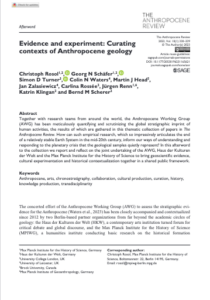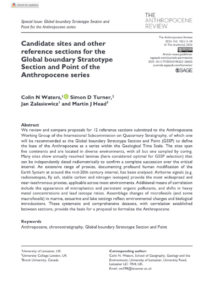Overview
Has human impact on the planet become so significant that humans could be considered a geological force? Have humans brought about a new geological epoch? Geologists at twelve sites around the world have been delving into ocean and lake sediments, into archives held in ice, peat, and stalagmites, to look for traces of the human impact on the planet that will be visible in the far future. They are attempting to define a Global boundary Stratotype Section and Point (GSSP): the lower boundary of a proposed new geological epoch: the Anthropocene. You can find out more about each of the twelve sites in this guide (best viewed in full screen), and learn about the official ratification process for a geological epoch via the accompanying text, conversation, FAQs, and audio. As they are published, the respective scientific research papers will appear at the end of each guide.
The notion of the Anthropocene as a new unit of geological time in which humans have significantly altered the planet goes back at least to the nineteenth-century Italian geologist Antonio Stoppani, who wrote of an “anthropozoic era” in 1873. The term “Anthropocene” has been in informal use since the 1970s and was popularized by atmospheric chemist Paul Crutzen in 2000. Since then, the idea has gained traction across a variety of academic fields and beyond. But unlike other geological epochs, such as the Holocene and the Pleistocene, the Anthropocene has not (yet) been ratified by the International Commission on Stratigraphy. In 2009, the Anthropocene Working Group (AWG) was established to evaluate the Anthropocene in geological, and more precisely stratigraphic, terms. Discussion of which geological evidence (a prerequisite for its inclusion in the International Chronostratigraphic Chart) would define it and where such evidence might be found continued up to 2019, when the AWG voted to decide that the Anthropocene should be treated as a formal chronostratigraphic unit defined by a GSSP and that it commenced in the mid-twentieth century.
Following that decision, twelve sites across the planet have been intensively examined as possible locations for the Anthropocene GSSP. These sites include deep lakes, marine basins, coral reefs, a river estuary, a cave, an ice sheet, a human-made reservoir, a mountain peatland, and an urban archaeological site. The cores range from an enormous 133 meters long to a mere forty-five centimeters, and each site has its own unique environmental and geological characteristics. But what unites them is that they constitute high-resolution archives of at least the last century and record global as well as local anthropogenic signals, including traces of mid-century nuclear bomb testing, fossil fuel combustion, industrialization, agriculture, and ecosystem change.
Locating geological sections that record at least the last century in enough detail that specific years can be identified requires a deep understanding of the conditions and characteristics of potential sites. Scientists who study geological successions to track past environmental and climatic conditions have such understanding, and so from 2016 members of the AWG began reviewing existing literature to determine whether environmental archives containing proposed markers of the “Great Acceleration” existed with high enough resolution to see annual changes. Since most analytical work is destructive, groups were asked if large enough samples still existed for multiple analyses to occur with sufficient core remaining intact to act as an archive following analysis (a requirement for a GSSP to allow future research). Some teams proposed sites to the AWG and were willing to take part in further research, while others were approached because of their previous publications.
Up until 2019, there was no specific financial support for this research; people were working on sections as part of their own academic research, as an offshoot of their doctoral research or other funded projects. Therefore, the sites do not represent a spatially-balanced global selection but rather reflect both individual and institutional interests as well as the financial, cultural, and practical constraints that shape environmental science research. This scientific work is thus both a legacy and a continuation of the social, cultural, and economic systems that have tipped us into a new geological epoch. In the Anthropocene, geology and history are no longer separate disciplines.
See the articles below for more information about the Anthropocene ratification process and the 10-year collaboration between the AWG, Haus der Kulturen der Welt and Max Planck Institute for the History of Science.
This article was published open access in the journal Anthropocene Review as Waters, C. N., Turner, S. D., Zalasiewicz, J., and Head, M.J. (2023). Candidate sites and other reference sections for the Global boundary Stratotype Section and Point of the Anthropocene series. The Anthropocene Review, 0(0). https://doi.org/10.1177/20530196221136422. This article is distributed under the terms of the Creative Commons Attribution-NonCommercial 4.0 License (https://creativecommons.org/licenses/by-nc/4.0/) which permits non-commercial use, reproduction and distribution of the work without further permission provided the original work is attributed as specified on the SAGE and Open Access page (https://us.sagepub.com/en-us/nam/open-access-at-sage).
 Evidence and experiment: Curating contexts of Anthropocene geology
Evidence and experiment: Curating contexts of Anthropocene geology
This article was published open access in the journal Anthropocene Review as Rosol, C., Schäfer, G. N., Turner, S. D., Waters, C. N., Head, M. J., Zalasiewicz, J., Rossée, C., Renn, J., Klingan, K., and Scherer, B. M. (2023). Evidence and experiment: Curating contexts of Anthropocene geology The Anthropocene Review, 0(0). https://doi.org/10.1177/20530196231165621. This article is distributed under the terms of the Creative Commons Attribution-NonCommercial 4.0 License (https://creativecommons.org/licenses/by-nc/4.0/) which permits non-commercial use, reproduction and distribution of the work without further permission provided the original work is attributed as specified on the SAGE and Open Access page (https://us.sagepub.com/en-us/nam/open-access-at-sage).
 Candidate sites and other reference sections for the Global boundary Stratotype Section and Point of the Anthropocene series
Candidate sites and other reference sections for the Global boundary Stratotype Section and Point of the Anthropocene series